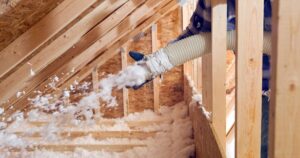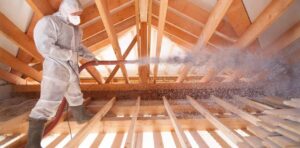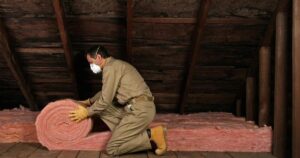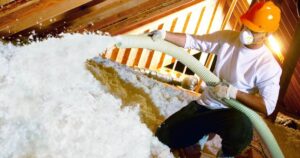The insulation was used for all types of purposes, including insulating walls, floors, pipes, ductwork, and boilers. It was also used to fireproof structural beams. The insulation can become a danger in the home, typically during renovations and repairs when it is moved, removed, or damaged. The movement of the insulation will cause toxic asbestos fibers to become airborne and potentially inhaled by occupants in a residence.
In this comprehensive guide, we will delve into the appearance of asbestos attic insulation, its potential risks, and the steps you should take if you suspect its presence in your home. It’s estimated that homes built from 1900 and throughout the 1980s contained insulation that was made with asbestos. Asbestos insulation was favored because it was strong and fireproof.
When it comes to home insulation, many older houses may have utilized materials that are now considered hazardous, such as asbestos. If you’re wondering, “What does asbestos attic insulation look like?” you’re not alone.
What is Asbestos Attic Insulation
Before we discuss its appearance, let’s clarify what asbestos attic insulation is. Asbestos is a naturally occurring mineral fiber known for its exceptional heat resistance and durability. It was widely used as an insulating material in homes, schools, and commercial buildings from the late 19th century through the 20th century. Due to its excellent fire-resistant properties, it was considered an ideal choice for insulation.
The Common Appearance
Asbestos attic insulation often comes in several distinct forms, each with its unique appearance:
Vermiculite Insulation
Vermiculite insulation is a popular choice in homes with asbestos-containing materials. It is light brown or gold in color and has a granular or pebble-like appearance. Vermiculite is often mistaken for mica due to its shimmering, reflective quality.
Asbestos Paper Insulation

Asbestos paper insulation appears as thin, papery sheets that are usually white or gray. It is commonly found lining heating ducts and pipes.
Asbestos Spray-on Insulation
Sprayed-on asbestos insulation looks like a fluffy, loose, or bumpy material, often with a textured surface. It’s typically used for soundproofing and fireproofing.
Asbestos Insulation Boards
These boards are usually gray or white, resembling traditional building insulation. They are
thick, rigid, and may have a rough texture on the surface.
Asbestos-containing Pipe Insulation
Asbestos-containing pipe insulation appears as a corrugated, wrap-around material, typically gray or white. It is commonly used to insulate pipes and boilers.
What to Do If You Suspect Asbestos Attic Insulation
Understanding the appearance of asbestos insulation is crucial because this material poses serious health risks. Asbestos fibers are microscopic and can become airborne when disturbed. Inhaling these fibers can lead to severe health conditions, including lung cancer, asbestosis, and mesothelioma.
| Action | Description |
| 1. Don’t Disturb | Avoid any unnecessary disturbance of the attic insulation. Asbestos fibers are harmful when inhaled, so keep the area undisturbed. |
| 2. Confirm Suspicions | If you strongly suspect asbestos, have a professional asbestos inspector or abatement contractor test a sample of the insulation to confirm its asbestos content. |
| 3. Seal Off the Area | Limit access to the attic to prevent any accidental exposure. Post warning signs and restrict entry. |
| 4. Avoid DIY Removal | Do not attempt to remove asbestos insulation yourself. Asbestos removal is hazardous and should be performed by trained professionals. |
| 5. Consult Local Regulations | Check local and state regulations for asbestos handling and abatement requirements. Compliance with these laws is crucial. |
| 6. Hire a Licensed Contractor | If asbestos is confirmed, hire a licensed asbestos abatement contractor to safely remove or encapsulate the insulation. |
| 7. Protective Measures | Ensure that the professionals handling asbestos wear appropriate personal protective equipment (PPE) and follow strict safety protocols. |
| 8. Notify Household Members | To inform all household members about the situation, the precautions, and the safety measures being taken to prevent exposure. |
| 9. Dispose of Waste Properly | Ensure that asbestos waste is properly sealed, labeled, and disposed of at a designated hazardous waste facility. |
| 10. Re-insulate Safely | After asbestos removal, consider re-insulating the attic with a safe, modern insulation material. |
| 11. Regular Maintenance | Continue to monitor and maintain your attic insulation to prevent future issues. |
The Importance of Professional Testing
Professional asbestos testing is a critical step in identifying and managing the potential risks associated with asbestos attic insulation. Here’s why it’s essential:
- Accurate Identification
Trained professionals can accurately identify the presence of asbestos in insulation materials. DIY testing kits can often yield inconclusive results, leading to uncertainty and potential health risks.
- Comprehensive Inspection
Experts will conduct a thorough inspection, assessing the condition of the insulation and determining whether it poses an immediate threat.
- Legal Compliance
In many regions, there are regulations and laws governing the handling and removal of asbestos-containing materials. Professional inspectors are well-versed in these regulations, ensuring that all procedures are carried out in compliance with the law.
Safe Asbestos Removal
If asbestos is confirmed in your attic insulation, the next step is safe removal. This is not a task for the average homeowner and should only be handled by certified asbestos abatement professionals. Here’s why professional removal is essential:
Safety First: Professionals are equipped with the necessary safety gear and tools to minimize the risk of asbestos exposure. They wear protective suits, and respirators, and utilize specialized equipment.
Proper Containment: During removal, experts create a controlled environment to prevent asbestos fibers from escaping into your home. This includes sealing off the affected area and using negative air pressure systems.
Disposal: Certified asbestos abatement specialists know how to safely dispose of asbestos-containing materials in compliance with local regulations. This often involves transporting the waste to a specialized disposal facility.
After Asbestos Removal
Once the asbestos insulation has been safely removed from your attic, it’s essential to take further steps to ensure the safety of your home:
Inspection
After removal, have your home inspected to confirm that all asbestos-containing materials have been successfully eliminated.
Repair and Renovation
If the removal process causes any damage, it’s essential to repair and renovate the affected areas while adhering to safe practices.
Preventive Measures
To prevent future asbestos exposure, consider improving ventilation and air quality in your home. Regularly inspect your property for any signs of deteriorating materials.
Health Monitoring
If you or your family members have been exposed to asbestos, consider regular health check-ups and screenings to monitor for any asbestos-related health issues.
FAQs
How do you identify asbestos wire insulation?
If the outside of the wire is black fabric and you can see white fiber where the bare wire is sticking out from the insulation then the wiring has asbestos insulation wrapped around it. The white fiber is is at least 50 percent asbestos.
Is asbestos a good insulator?
Asbestos was long considered an ideal material for almost all types of insulation.
Final Thoughts
Understanding what asbestos attic insulation looks like is just the first step in ensuring your family’s safety. The key takeaway from this guide is that asbestos is a hazardous material that should be handled with caution. If you suspect its presence, never attempt to deal with it on your own.
Always seek professional assistance to properly assess, manage, and, if necessary, remove asbestos-containing materials from your home. Prioritizing safety and compliance with regulations is crucial in protecting the health and well-being of your loved ones. Remember, asbestos is a health hazard, and protecting your family should be your top priority when dealing with it.










